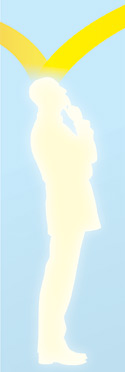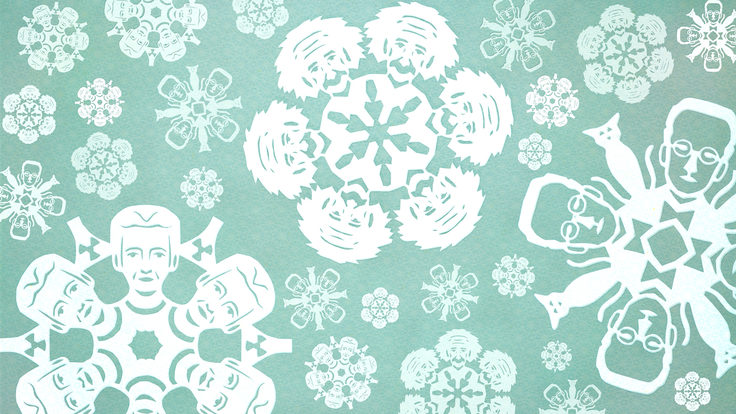Free for all
Forget about paying for journal subscriptions. If a new proposal takes hold, particle physics journals would get their funding from labs, libraries, and agencies that sponsor research, and readers could peruse them for free.
By Glennda Chui
 |
| Illustrations by Sandbox Studio |
The next big experiment in particle physics won’t need an accelerator, detector, or other big machine. It doesn’t even involve subatomic particles—unless you count the electrons that flow through electronic circuits, carrying bits of information from one human brain to the next.
Instead, it will test a new way to circulate the theories, methods, and experimental results that are the lifeblood of science.
If it works, no one will have to pay to read most particle physics results. The journals that publish most of the research in the field will be available free online to anyone, anywhere and any time. Money to run the journals—including the cost of having experts review each article before it sees print—would instead come from funding agencies, laboratories and libraries through a consortium called scoap3, the Sponsoring Consortium for Open Access Publishing in Particle Physics. This would give journals a stable source of funding while reducing the total cost to libraries and readers.
The proposal is the latest twist in open-access publishing, a worldwide movement whose goal is to pull down barriers to the free flow of information while preserving a system that has kept watch over the integrity of science for nearly 350 years.
Physics, with its long history of openly sharing research results, seems an ideal testing ground for such an idea. Fifty years ago physicists began circulating mimeographed preprints, or unpublished papers, as a way of getting results out more quickly. The mimeograph gave way to the copying machine and the computer; today’s physicists post theories and experimental results on arXiv.org, an Internet clearinghouse set up in 1991 to make it easier for them to swap information. Some of these articles have been through the rigors of expert review, but many are fresh from the keyboards of their creators. As of July, arXiv contained more than 430,000 articles in physics, mathematics and computer science, with more than 56,000 new submissions expected in 2007 and more than 45 million full-text articles downloaded per year, according to Paul Ginsparg, the Cornell University physicist who created the service and manages it. As early as 1961, librarians at Stanford Linear Accelerator Center in California started keeping track of circulating preprints, an effort that evolved into spires, the first searchable database on the Internet.
“A lot of people cite or use papers before they have even been published in a journal,” says Travis Brooks of SLAC, who manages the spires database. “Because of this way of doing things, this field moves at a much more rapid pace.”
But when it comes to extending open access to the journals themselves through scoap3, there are formidable obstacles and worries: Who will pay for publication? Would the funding be stable enough that journals could rely on it?
Further, the consortium won’t work without participation from all the countries where physics is done. The United States is a crucial player, since about a quarter of the published research originates here. Yet its budgetary system is highly complex, with money for journal subscriptions coming out of thousands of separate pockets. If the bulk of particle physics results emanated from a handful of big labs, the situation would be simpler; they could be asked to foot the bill. But 90 percent of the peer-reviewed articles posted in arXiv are written by small groups of theorists, and they’re scattered among many institutes and universities. Proponents say the fact that two major libraries recently expressed an interest in working with scoap3 is quite encouraging.
The price of excellence
Ever since Britain’s Royal Society founded the first scientific journal, Philosophical Transactions, in 1665, journals have played a critical role in the way science is done, one that goes far beyond disseminating knowledge. They do this through a process called peer review, in which research results are scrutinized by experts, and often put through many rounds of back-and-forth fine-tuning, before they’re approved for publication.
It’s an expensive undertaking. For the American Physical Society, a not-for-profit professional organization, the cost of publishing nine journals is about $30 million a year, says Joseph Serene, the society’s publisher and treasurer.
 |
The society gets about 35,000 manuscripts per year and publishes 16,000 to 17,000 of them, he says. It has a list of 50,000 scientists who volunteer to review those papers, and employs 50 full-time editors, all PhD physicists. The final cost of producing an article is about US$2000.
However, the average cost of journal subscriptions has been rising far faster than inflation; between 2003 and 2007, for instance, the average cost of subscribing to 103 physics journals jumped 42 percent, according to the 2007 Library Journal Periodical Prices Survey. Many library budgets can’t keep up. Some have been dumping subscriptions; in October, for instance, the society that runs Germany’s Max Planck Institutes announced that it was cancelling an agreement with Springer that gave the institutes a centralized way to access 1200 Springer journals, adding that it would work with individual institutes to obtain “essential content” at a reasonable price. “Extreme price developments in the supply of information, as well as usage restrictions, are prompting scientific organizations around the world to rethink their policies,” the society said in a statement to the press. “If publishers have the market power to effectively implement such prices and if legislators are unwilling to subject such inappropriate behavior to legal controls, the only way left open to science will be to take matters into their own hands.”
As more institutions pare their subscription lists, there’s a danger that journals will have to raise prices for their remaining subscribers, leading to more cancellations and more price increases that eventually force journals out of business. “The present system is not sustainable.” says Salvatore Mele, a physicist at CERN, the European particle physics laboratory in Switzerland, and spokesman for the scoap3 project. “When we run out of money because the subscriptions are too expensive, we might run out of journals, and our community needs our journals for the evaluation of research groups and individuals, in particular young scientists on the tenure track. Journals are our interface with officialdom; today they are indispensable.”
 |
Green and gold
It didn’t take long after the 1983 birth of the Internet for the first open-access journals to appear, according to a timeline put together by Peter Suber, a research professor of philosophy at Earlham College in Indiana and one of the movement’s most active proponents. By the time CERN computer scientist Tim Berners-Lee launched the World Wide Web in 1990, open-access journals had sprouted in the areas of adult education, psychology, communication, computer systems, and postmodern culture.
Today there are more than 2900 open-access journals, including 39 in physics, according to a database maintained by the Lund University Libraries in Sweden. A recent survey that Suber carried out with Caroline Sutton of Co-Action Publishing found 468 scholarly societies publishing 523 journals with various degrees of open access, including those put out by the American Physical Society.
In talking about open access, advocates refer to two basic ways of going about it: the green and gold.
The green road is what physicists have been doing all along—making their work available on the Web, whether on a central repository such as arXiv or on their own home pages. Activists would like to spread these practices to other fields. They celebrated when both houses of the US Congress voted to mandate that research funded by the National Institutes of Health be posted on an open archive within a year of publication; however, President Bush vetoed the measure in November. A publishers’ group called prism, the Partnership for Research Integrity in Science & Medicine, opposes this and any other form of mandatory open access.
Under the gold model, journals make their contents available free, with the cost of publishing generally paid by authors or by their home institutions. Unlike the green road, it explicitly provides a way to pay for peer review. In physics, gold journals include Advances in High Energy Physics and the recently launched PMC Physics A, which posts articles in a way that also allows readers to access and manipulate the underlying data. “We won’t be publishing issues; we’ll just publish articles as they are accepted, so the speed of publication will be that much faster,” says Christopher Leonard, associate publisher of London-based PhysMath Central. “Eventually we intend to launch enough open-access journals to cover the whole of physics and the whole of mathematics.”
A growing number of journals are hybrids: They continue to sell subscriptions, but will make individual articles available free online if the author pays a fee. This model was pioneered by Springer in 2004.
scoap3 offers another alternative.
Noting that 83 percent of published particle physics articles posted on arXiv are from six leading journals, the international consortium proposes to convert five of those core journals to full open access: Physical Review D, Physics Letters B, Nuclear Physics B, Journal of High Energy Physics, and European Physical Journal C. In addition, articles in Physical Review Letters that involve high-energy physics, about 10 percent of the total, would become open access. The consortium is also open to other high-quality particle physics journals.
Each nation that carries out physics research would contribute to the consortium according to how many articles its scientists publish, with special allowances made for developing nations that cannot afford to pay.
One concern raised about open-access publishing is that it might free libraries from the burden of skyrocketing subscription costs, only to force authors to pay fees out of their research grants, reducing the amount of money available for lab equipment, graduate students and other essentials. scoap3 offers a way around that, Mele says, by diverting money now used for subscriptions into the consortium while leaving research funds intact.
At a cost of about US$3000 per article and with about 5000 articles published per year in the field, the maximum yearly price tag for open access would be about US$15 million, he says.
The proposal is making rapid progress, Mele adds: The major European players have already pledged about a third of the needed funding, and there are growing signs of interest from libraries in the United States and both libraries and funding agencies in Asia.
Ivy Anderson, director of collections for the California Digital Library, says the library is exploring the feasibility of becoming a scoap3 funding partner on behalf of the University of California Libraries.
She calls the funding model “both intriguing and innovative,” adding, “Any proposal that holds out promise for placing scholarly publication on a more sustainable and open footing is very welcome.”
Heath O’Connell, information services manager for Fermi National Accelerator Laboratory in Illinois, says his library is “very interested” in redirecting its subscription costs to scoap3 “and many high-energy physics libraries, such as SLAC’s, are thinking in similar ways.”
 |
The publishers
For their part, the biggest publishers in particle physics—Elsevier, Springer, and the APS—all say they’re receptive to the idea, if it can be made to work.
Springer recently announced that until negotiations with the scoap3 consortium are concluded, all of the experimental papers published in European Physical Journal C will be available for free.
“In a way, a publisher has to be agnostic on these things. This is a matter of politics, funding, and science,” says Christian Caron, publishing editor for EPJC. “What is rather clear is the majority of big collaborations in this world have signed petitions saying yes, we are only going to publish in open- access journals.
“We’re totally open-minded. We’re curious to see what will be in the proposal. We will have to all sit down and ponder how sustainable that is, and what is the risk associated with that.”
Even among supportive publishers, there is a fear that the transition to open access could be rough, and might even put them out of business.
“We would be delighted if the scoap3 initiative worked,” says Serene of the APS. “But we would be hesitant to sign onto this thing unless we were really certain it had long-term financial stability,” which is hard to guarantee if the funding comes out of government budgets that change year-to-year.
While subscriptions to the society’s journals have declined over the past decade, he says, “If you look at the numbers, the subscriptions are solid. I will say we worry that we might be sitting on some point of unstable equilibrium and things might change rather rapidly.”
To Suber, though, physics is offering scholarly publishing a model for how to make that transition.
“Somehow physics did everything right,” he says. “Its levels of self-archiving are approaching 100 percent, and its journals have not seen cancellations. In physics we’re seeing the journals convert even when they’re prospering, and they’re doing it through coordinated negotiations with other stakeholders. It’s being done through discipline and reasoning. Nobody is over a barrel. Everybody’s doing it because it looks like a better idea.”
If other fields can move to open access through this kind of “peaceable negotiation, rather than trauma,” he says, “we should do that.”
Click here to download the pdf version of this article.






